#generalist game dev
Explore tagged Tumblr posts
Note
Hello, I'm an aspiring game developer generalist but I honestly have no clue where to start, and my lack of attention span does not make it any better, do you have any advice on how to start learning to become a generalist?

It really depends on what you want to do. If you want to be a hobbyist, then I suggest reading my guide on the [minimum competence needed] to be able to contribute to a game development team. Then, start doing each of these things - write code, create art assets, build a level, make something playable. As you learn to do these tasks and level up, you'll become a generalist that's able to make a lot of contributions to a dev team.
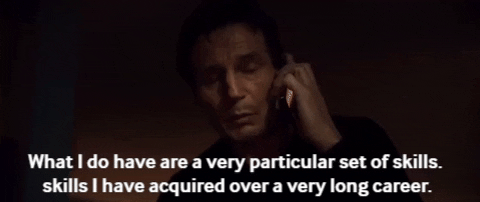
If you want to be a professional generalist, the requirements are much more stringent. Generalists in the game industry really only exist at the upper mid-senior level, there really aren't any junior generalists because the juniors really lack the experience shipping and finishing games. A junior might enter without a specific specialty, but they have a lot of learning to do. It's much easier to learn one major thing at a time than it is to learn many things all at once, especially when the goal is delivering shippable quality results.

The minimum bar for competence for professional generalists is much higher. A professional generalist isn't someone who knows a little of everything and can get something started, it's someone who can finish a wide variety of tasks. A professional generalist can operate and produce work of shippable quality in multiple areas. I've personally worked on cameras, economy, combat, monetization, characters, AI, progression, animation, cinematics, localization, and lots of other game systems in my career.
[Join us on Discord] and/or [Support us on Patreon]
Got a burning question you want answered?
Short questions: Ask a Game Dev on Twitter
Long questions: Ask a Game Dev on Tumblr
Frequent Questions: The FAQ
#generalist game dev#getting started with game design#getting started with game programming#the very basics#career advancement#game development career
22 notes
·
View notes
Text
wanting to make games but not having the motivation, attention span, and technical skill to do it all yourself. many such cases.
I'd say the better solution to achieving your indie success dreams is to form a team instead of going alone but then you just have multiple people all losing motivation and attention span instead of just one
#forming a small team is a much better option though#one dev games can be very impressive but dont put that pressure on yourself#i think for games in particular having a few specialists in different things is waaaayyyy better than a team full of generalists
4 notes
·
View notes
Text
When we cast the stars, the 𝖃𝖊𝖗𝖝𝖎𝖆𝖓 𝕾𝖚𝖓 reveals . . .

🌴Artist sima.gameart!
Hi, I'm sima.gameart! I'm a freelance 2D Generalist and Illustrator passionate about Anime, Manga and Games. I previously worked in Game Dev but now I'm focusing fully on illustration and animation. My favorite FMA character is Izumi Curtis but I also love the flame alchemy of Mustang. Writing this really makes me wanna watch FMA again…
Seek them on IG!
1 note
·
View note
Text
Forefront post: Moody sky environment
28/07/2024
This landscape in Unreal Engine was created by Gal Ravid-Tal, 3D/Unreal Generalist & Compositor. The environment consists of moody clouds, a mixture of grassy and rocky terrain, and a variety of smooth and sharp stones and cliffs.
They begin by explaining their choice to use Unreal Engine 5. “I chose Unreal Engine due to the incredibly fast and visually stunning results it enables. This speed allows me to create many more iterations, test new ideas, and do it all, without spending precious time waiting for renders. The ability to see my lighting, change material properties, and test new composition ideas in real-time is a huge game-changer for me.” (Levine & Ravid-Tal, 2024)
This is a sentiment that many people will share, as Unreal Engine is an excellent piece of software for the exact purpose Gal Ravid-Tal needed. I myself plan to render as much of my work as possible in Unreal Engine, unless I specifically need to use Blender’s render engine “Cycles”, after creating an asset in it.
They also go on to mention about how “Unreal Engine is gaining popularity in the VFX and Virtual Production industry, making it an essential tool for any artist's toolbox.” (Levine & Ravid-Tal, 2024) I agree with this statement and plan to keep developing my skills and knowledge with Unreal Engine in order to both improve my work and increase my employability, as I’m not opposed to going down this route with my career, not just staying in the games industry.
They go on to talk about the inspiration for the project, this being a mountain in England called Glaramara, in the Lake District. They go on to say about how they were inspired by the “dramatic clouds, varying hues of grass, the mix of both smooth and sharp stones, and cliffs” (Levine & Ravid-Tal, 2024) and that this project provided an “opportunity to practice environment creation, lighting, and look development.” (Levine & Ravid-Tal, 2024) They began as everyone should, by gathering plenty of reference images of the same or similar areas, but they focused on having images with different lighting conditions to help them understand the varying values over the landscape. This is something I haven’t really thought about before when gathering references, so from now on I’ll try to remember this as I’m sure it will prove useful in future should I be stuck on lighting or texturing within a project.

Next, they went over the composition of the shot where they “aimed to replicate a cinematic drone movement, which is commonly seen today”. (Levine & Ravid-Tal, 2024) Now the shots in the showreel look good, but I personally prefer using shots that resemble what a person would capture by themselves instead of using a drone. This is because, just like in moves and TV, I find there’s greater immersion if for example it looks like a person got a shot walking along the ground instead of having the camera fly through the air, though it definitely has its uses, especially if you’re trying to show off an environment
From there they went over the materials. They used the reference images to determine various properties of the environment in order to get consistency in different lighting conditions. But then they go on to talk about a material system they made, what it can do, and the goals for it. By the looks of things, it seems very useful but it isn’t out yet though they mention later on that it’s been in development for 6 months, there is a plan to create a demo and tutorial, and to sell it on various platforms.
For the actual terrain, Gaea was used, where multiple terrains were used I unison so they made a continuous terrain, with a focus on a hero mountain in the centre. I have yet to use Gaea, but the next time I need to make a terrain I’ll definitely give it a go. There was also a useful tip for emphasising the scale of the scene. “To emphasize the scale, I created slow camera movements to mimic a drone shot. Using closer foreground objects and distant mountains enhanced the parallax effect, adding depth and interest to the scene.” (Levine & Ravid-Tal, 2024) The lighting consists of the directional light, and a HDRI backdrop for the background and the indirect lighting. Then simply using height fog for the atmosphere.

The article is closed out with plans for working on the material system, some advice for aspiring developers also trying to make systems and two YouTube channel recommendations who cover topics relating to Unreal Engine.
In summary this project, as well as looking incredible, is an excellent example of the process one should take when creating a scene or asset. From references to execution every step is thought out and the software used effectively to create the best end result possible. The explanation of the process was clear too, and I’ll also be keeping a lookout for that Unreal Engine plugin.
References
Levine, G. & Ravid-Tal, G., 2024. How to Create a Photorealistic Grand Terrain in Unreal Engine. [Online] Available at: https://80.lv/articles/how-to-create-a-photorealistic-grand-terrain-in-unreal-engine/ [Accessed 28 July 2024].
0 notes
Text
Apex Legends - Season 8: Mayhem
Season Release Date: February 2nd, 2021 Platforms: Playstation 4, Playstation 5, Windows PC, Xbox One, Xbox Series X/S
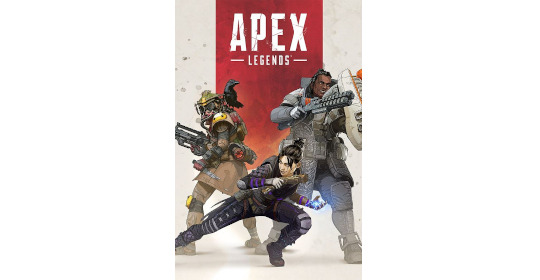
Apex Legends is a free-to-play battle royale-hero shooter game developed by Respawn Entertainment and published by Electronic Arts. The game is set in the same science fiction universe as Respawn Entertainment's Titanfall series, with several characters from the Titanfall series appearing either as minor characters or playable Legends. Before a match, players form into two- or three-player squads, and select from pre-designed characters with distinctive abilities, known as "Legends". In "Battle Royale", up to 20 three-person squads or 30 two-person duos land on an island and search for weapons and supplies before attempting to defeat all other players in combat. The available play area on the island shrinks over time, forcing players to keep moving or else find themselves outside the play area which can be fatal. The final team alive wins the round.
I was privileged to join the revered Respawn Entertainment Apex development team mid way through 2020 as a gameplay generalist that spent time prototyping and pitching new weapon and legends ideas. This allowed me to grow my design skills in other areas of the discipline and learn from leading industry creators!
As scope and season requirements where laid out for the Season 8: Mayhem deliverables, I was asked to further stretch both my design and technical skills by developing new game mode modifiers for the Season's events. This work included pitching, prototyping and rapidly playtesting new ways to shake up the Battle Royale formula - nothing was off the table. Numerous game modes were prototyped, tested and iterated on. We ended up landing on 5 solid ideas that were each unique in which parts of the game that they changed or altered. They each were a huge hit with players and the internal dev team alike; creating fun and engaging new ways to the play "Battle Royale".
These game modes launched at the end of the season 8 under the War Games Event! Each game mode breathed fresh life into the standard "Battle Royale" experience, promoting new strategies and squad tactics for players to explore. Each game mode was only live for 2-3 days over the course of 2 weeks, shaking things up for players and paying homage to the season's theme. Check out the War Games Event Trailer below!
youtube
Here are the 5 Game Modes and their mechanics:
Second Chance
In this modifier, each Legend is granted one free respawn per match. Once a Legend is killed, their Respawn Token is consumed as they rise again from their current location retaining all their weapons and gear. After a short duration, the player respawns high in the air to skydive back into the action.
Ultra Zones
Shake up your ideal drop strategy with Ultra Zones! Ultra Zones introduce the concept of multiple Hot Zones within a single map. More epic loot, more gold items! But wait, there’s more! Each Hot Zone is enveloped in a Flash Point—a returning feature from a Season 6 LTM. For those who don’t already know, Flash Points are enormous, glowing bubbles that replenish your HP and shields when you stand in them.
Auto Banners
In this modifier we’ve made a rather small but spicy change to squadmate respawning. Your Squadmates Banner Cards are automatically retrieved! No need to loot their death box to retrieve their Banner Cards, just head straight to a respawn beacon. The loot pool has been altered to contain more Mobile Respawn Beacons too.
Killing Time
Feel the pressure with Killing Time. This event speeds up the match as Legends fall. During a round, whenever a Legend dies, the round time is reduced. If any given round is a massacre, you can bet that ring will be closing real quick! Keep an eye on the round timer and the ring in this modifier.
Armor Regen
Your armor regenerates over time at a rate of 12 points per second. Whenever you take damage, your armor will begin regenerating after an 8-second delay. This delay is doubled to 16 seconds if your armor gets cracked (reaches zero). One last thing for this mode: there are no Shield Cells in the loot pool!
Below is some footage of a prominent APEX Streamer playing the Second Chance game mode. Enjoy the chaos!
youtube
0 notes
Text
vent
tldr i just don't live up to the standards of most artistic communities and i don't think there's very much i can do about that, which makes me feel awkward about participating in those communities, so i don't, which makes me stagnate alone
something that permanently really upsets me is that i can't ever produce clean art or music. the inability to make myself do things even when i want to if they're difficult makes it extremely hard for me to practice anything and so i don't get better, and then whenever i try to get involved with artistic social groups it causes me this sort of bone-gnawing shame because i can't produce work on command like they can and i everything i make is messy garbage and it makes me feel like my relationships are horribly unbalanced. i don't want to show anyone my mediocre work because i'm afraid of them looking down on it, but also i want to post all my work because if people don't tell me they like it i can't get myself to do it.
i understand imposter syndrome and so on but it's really not that, it's my social difficulties and lack of innate drive make it very hard for me to keep learning, to keep improving, to do fucking anything in any reliable way, which leads to very real differences between what i make and what people expect in artistic communities. so ultimately it's just led me to give up in a lot of ways on trying to interact with other people in game dev or whatever, and to view any that try to be my friend with terrified caution/anxiety because it's like. why are you here? don't you have your fellow devs to be hanging out with? i'm just building sand castles, please don't look down on me. i'm sorry for disappointing you by not being that good
i think at the end of the day if i was just oblivious to this self-frustration and could interact in communities more i would get better naturally, but then again, my adhd tendency to wander from being obsessively into something at periods makes it really hard for me to ever get to being good at anything. it's so fucking difficult to get started working on something and doing it when it doesn't make you happy because it's not good enough yet and it's all just this sort of miserable ball of nightmares that makes me sad because i don't think i'll ever be as good as like the average expected fan creator these days now
i just look at everything i make and am struck by how lazy and uninspired and derivative it is, and i want to shoot myself in the head sometimes, it's so fucking frustrating and i don't even know why i make these posts because i don't know what i'm going to do about it. i already know i don't have the drive to become as good as specialists and i know that my attempts to be one have failed in the past. i just have to accept being a generalist who's tolerable at everything but not very good at anything and try not to hate everything i do
1 note
·
View note
Text
What Ascendant playtest class would be best for you, a guide.
Because I'm a stupid maniac who can't stop dev work even when I have a mental breakdown from stress and the weight of the world, the Ascendant V0 Playtest (which is not public and never will be) has 10 core classes for any poor motherfucker who decides to play the game to choose from; but which one would be right for you? Lets find out...
THE ADHERENT
The love child of the PF2E Magus and the DnD5E Warlock, the Adherent is a mobile skirmish-fighter with the ability to do the most stupid thing possible, but spells into their sword. Thats right, instead of abusing range, you can run right up to the man who just shot you in the face and hit them with a fireball, by putting it inside of your sword. Fun! Adherents gain the ability to slap spells into their sword by making deals with extremely dubious entities and being general edgy fuckers. The Adherent is the perfect class for somebody who wants a mobile skirmish fighter, but be warned: They lack flexibility with their spell list.
THE ARCANIST
The Arcanist is the world's biggest nerd. Instead of just abusing the unmatched power of the void, or being born with an actual miracle inside of them, or drawing the negative energy from the earth, or making a deal with an actual live demon... Arcanists went to school and studied a whole lot. Arcanists are generalist casters, able to access the most flexible list of spells and excel at AoE damage and utility-based casting; their core feature, Surge, allows them to empower their spells for greater effects.
THE CAVALIER
Do you want to be a dashing, roguish fighter with the ability to dazzle and confuse your enemies with your giant coat and dashing good looks? You should play a Cavalier. The Cavalier is a Dueling specialized martial character who is extremely cocky and good at lying. Their main feature is Flourish, which allows them to wave their sword in a funny way and gain a special dice they can use to do things like... impale their enemies on their swords. The Cavalier is generally just a dashing duel-oriented character, ideal for somebody who likes playing somebody with a severe narcissistic disorder.
THE BEHEMOTH
Do you want to be the Wall? Do you want to embody the spirit of the Destiny 2 Void Titan? You should play a behemoth. Behemoths do one thing super well: Take damage. They gain a specialized Taunt ability that allows them to draw enemy focus, and gain special access to the elusive d12 hit dice, something nobody else has. They gain access to a list of maneuvers based around supporting their teammates and making them the biggest target possible, they are cool, I like them. The Behemoth is ideal for people who want to play out the 'Tank' fantasy and take the frontline for their squishier teammates.
THE EXECUTIONER
do YOU like outputting so much damage your Game Master starts to claw their own eyes out? Do YOU wish that the Rogue from Dungeons and Dragons Fifth Edition was actually viable? Do YOU want to have a giant sword and hit people so hard their ancestors feel it? Then the Executioner is the right class for you. The Executioner core ability is called... wait for it... Execute. It allows them to add a whole fuck ton of d10s to a very special melee weapon attack when a hostile creature is suffering from an illness or other condition like blinded, or stunned, or grappled, or damned, or any other of the stupid effects I've written. The Executioner is great for somebody who wants to work with their team and put out massive nova damage.
THE SHAMAN
Do you want to play somebody with magic but also a whole bunch of customization options? Do YOU want to commune with the eldritch spirits of nature and call down curses of actual death upon your foes? Do YOU want access to the best battlefield control spell list in the entire game? You should play a Shaman! Shamans gain a special feature called Cruses; Curses actively drain your Sanity but provide either a powerful negative effect or a large aura for your teammates to take effect of. Shamans also gain the ability to tap into other classes' spell lists, or turn themselves into a bear if you choose Circle of Beasts. The Shaman is a great class for anybody who wants to play a customizable half-caster with the ability to be built into anything you really want.
THE TEMPLAR
If your girl wears heavy armor, can smite their foes with the power of god, has a d10 hit dice (when all the other martial have a d8), and can heal people, that's not your girl. That's a Templar! The Templar is a frontline support tank. They're frankly the most complicated class, and have a whole slew of subclass options. They can be specialized into either support or damage, and gain special powers they can use through their class resource, which is the Divine Strength Dice. A pool of d6 they can use for healing, hurt, or to channel the will of GOD (whichever one you like) to do all sorts of fun things, like go fast, or make everybody really really scared. The Templar is a good class for anybody that wants to play a frontline tank with the ability to output good damage and heal.
THE THAUMATURGE
Has your mom or parental figure ever told you you were special? Because the Thaumaturge probably never needed to be told that. The Thaumaturge is a very special boi who was lucky enough to actually be blessed by GOD (whichever one you like) and now is extremely good at doing things like... healing, and burning people with the sun. The Thaumaturge is all about one thing: support. Their core feature, Inner Strength, allows them to restore allies' hitpoints AND sanity, and they gain access to a wide variety of team buff, support, and divine damage spells. The thaumaturge is a good class for you if you want to fulfill a supportive and blessed role in your party.
VOIDWALKER
because some people like to drive themselves insane, and the voidwalker is that guy. The voidwalker looked at the infinite sentient expanse of The void and decided 'imma make it my bitch' even though it could just delete them instantly. The void walker says 'fuck it, we ball' and actively degrades their mental health to roll obscene amounts of dice and add them to their spell damage. Given the fact that they have the second-most damage-focused spell list in the game, you can literally just roll 100d6 and say 'ok fuck you GM, I deal 500 Chaos Damage'. The Voidwalker is a good class for people who want to say 'fuuck it we ball' and delete their mental health while dealing stupid amounts of damage and have a d4 hit dice.
WARRIOR
Do you want to use sword good? Play a warrior. Really I mean it, the Warrior is the premier damage class. Able to use a ton of weapons well, and hit things a ton with their Critical feature, Press Advantage. So when you crit, you get to attack again, no matter how many times you've attacked. If you want to play somebody who's a master of combat, and has some of the most wildly varied subclasses (and most flexible maneuvers) in the game, you should play a Warrior!
And that should do it. I'll see y'all never!
0 notes
Text
X, formerly Twitter, has made another step toward becoming an “everything app” after Elon Musk tested out video game streaming on the platform. In a 50-minute-long stream on Oct. 6, Musk streamed himself playing the popular online action role-playing game Diablo 4. Stream Test 3 https://t.co/1ih0ZAY2tS— Elon Musk (@elonmusk) October 7, 2023 As things kicked off, Musk outlined that “what we are aiming for here is that the audio sounds normal, the image looks reasonably good so it's not flickering, and the comments are working.”While the feature is still in its early stages of development, the quality of the stream remained consistent throughout, with Musk seemingly chuffed with the work the devs have put in so far. “It's cool that it works at all,” he said. Toward the end of the stream, Musk answered some questions from his viewers and provided more context on what X is aiming for. “We will add in streaming for Xbox and PS5. You know we're not trying to do everything better than every other app, but we wanna say that ‘okay if you wanna do something within the X system or the X platform, you can do it if you want,” he said, adding: “I think the very specialist apps are still gonna be probably better than us in a lot of ways but you know, I think we can be the best generalist app. There's some value to being a generalist app for I guess discovery, and for interacting with the largest number of people in the world.” Musk, however, did not reveal anything about payments or crypto being integrated with streaming for aspects like subscriptions or donations etc. Elon Musk explaining his Diablo character build. Source: XThere seems to be a significant amount of interest in the move. At the time of writing, the stream or “broadcast” has had 2.8 million viewers in just a few hours since the session ended, while the tweet highlighting the stream has a whopping 9.3 million views and more than 5,300 retweets. Following the rebranding from Twitter to X in July, Musk explained that it was part of his plans to develop an “everything app” that essentially hosts a wide array of social media features and supports financial services, including crypto. This focus has seen Twitter introduce the revenue share model for X Premium subscribers, among a host of other features, and to offer users the ability to post videos and content directly on the platform.
0 notes
Photo

A memory of college.
Lately I’ve been going back college projects I never finished and revamping the hell out of them... or into them in this case.
Stay tuned for a sketchfab link so you can thoroughly enjoy this nightmare I survived.
For the most recent updates, follow me everywhere!
Instagram - 3bre_art
Facebook - 3BreArt
Twitter - 3bre_art
#classroom#3d model#3d art#maya#video games#gamedev#scary#nightmare#creepy#abandoned building#game dev#game dev blog#3d artist#3d generalist#game art#spoopy#hell#hell gate#college#artists on tumblr
3 notes
·
View notes
Text
An Amateur’s 3D Creation Tutorial
Intro
Hi, it’s Kai Yuan, your resident 3D generalist of Noodlets Studio. I’m currently writing this while having a minor cold so I’m sniffling every 5 seconds while bopping to the range of Lady Gaga to Lorde to Conan Gray, stay healthy everyone! In order to make up for my apparent lack of dev logs, I’m going to show you how I create a little stove for Yi’s Eatery. All points made here are going to be super condensed for the sake of not running this article too long.
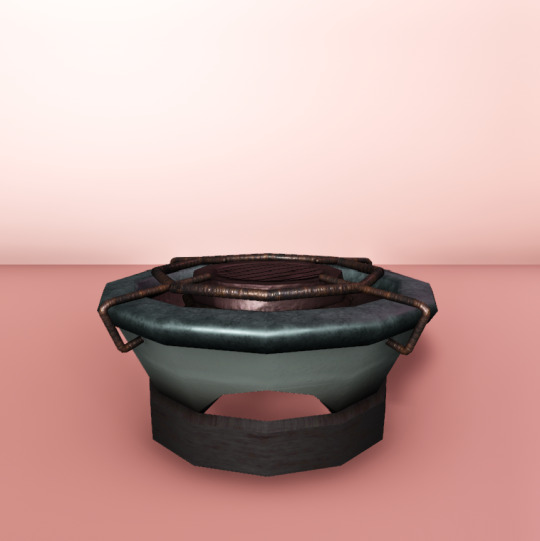
As with all of our tutorials, we are just amateurs having fun making games and sharing our experience as amateurs with you! :D
The Process
Step 1: Preparation
Always start with a plan in mind! I say that although I always start creating 3D assets with only 2 active brain cells half the time. Either way, you should still have a plan. This means first of all, gathering references of whatever object you want to create (even if you have a concept art to work off from) and beginning to understand your object’s form. With the stove I created, I used this particular reference image.

You can already see the similarities but these similarities help to sell the object as real. The closer the form of the object is to an actual reference in real life, the more believable it is even if rendered in a non-realistic way.
Once you have enough references and you start to slowly grasp the object you want to create, you should start pinpointing the basic shapes and forms of the object. In the example of the stove, it’s easy to notice that it has a cylindrical shape. Some objects have different components (EG: A car engine) and each component may have a different shape. It’s all about analysing your object and deepening your understanding of the object you want to create.
This preparation process doesn’t take too long for most objects, since a google search and basic shape knowledge is all you need. But taking the effort to prepare will save you a lot of blank staring at your 3D software.
Step 2: Modelling
Here’s where the nitty gritty starts to happen. I will preface this by saying that I frankly can’t show you the full process because you’d be reading this till the next day. We have a Youtube video on our Noodlets Studio channel where I modelled the stove on a livestream if you’re interested. In this article, I will just mainly share the important concepts for 3D modelling using the example of the stove.
The creation of all 3D objects follows the simple process of starting with big shapes and then slowly “zooming in” and editing the 3D object with increasing detail.

The above picture illustrates this concept of going from big forms to small details. This is where the knowledge from your preparation comes in. It really helps during the start when you have to block in your big forms. In the example of the stove, I start from a single cylinder and slowly build out the shape as shown in the picture above.
A few functions I like to use (in Maya) when adding in details are the “Bevel” function and the “Insert Edge Loop/Multi-cut” function.
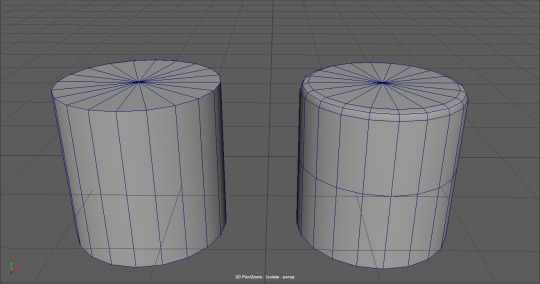
These functions simply revolve around adding more edges/points to manipulate, which is the basis of how you add more details in your 3D object. More points = more details.
When you are adding details to your objects, you have to be mindful you are not adding too much details. Not every corner needs to be beveled and you certainly do not need to unnecessarily cut edges if you are not going to move/extrude them. More points = more details BUT also = more computational power used to render 3D objects. The art style of your game also determines how you model your 3D objects, some require low polygon counts to achieve a cartoon look, some require higher polygon counts to achieve a realistic look. Although, most of us generally prefer the former because it’s easier to do.
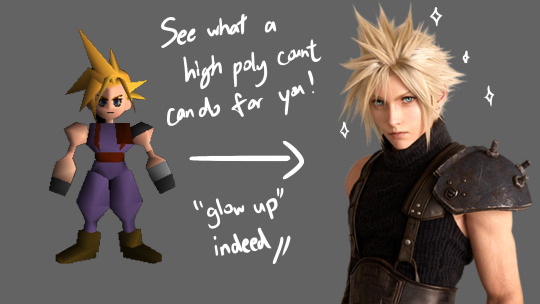
Step 3: Texturing
The next step after modelling your object is to UV unwrap it. UV unwrapping is the process of creating a UV map where a 2D image can be projected onto the 3D object’s surface.

In the example above, all the faces of the cube were laid out on a 2D plane, which then a texture can be projected onto the UV map and have it reflected on the 3D cube. This is merely the simplest example of a UV map, most UV maps are more complex and require a strong understanding of shapes. For example, this is the UV map for our stove that we created.

Most 3D software allow you to do UV unwrapping of your 3D models, although, you might want to look up a few dedicated tutorials first before jumping into it. This part of 3D modelling is easily one of the most frustrating and difficult parts to understand as there is 0 creativity involved, just pure brain power. :(
Once your 3D model is fully unwrapped, now you want to actually texture it. The simplest way of doing this is to export your UV map into Photoshop or any painting software of your choice and simply paint on it. However, there are a few caveats to take note of. You cannot physically see how your painting affects your 3D model without exporting the texture out into your 3D software. Thus, editing your texture map will be a long arduous process of importing and re-exporting.
In order to circumvent this, we can use dedicated 3D texturing software like Substance Painter which lets you see how your texture is reflected on the model itself. It has the further advantage of allowing you to further enhance your texture with some neat tricks. With a normal map, it will create the illusion of details on a flat surface.
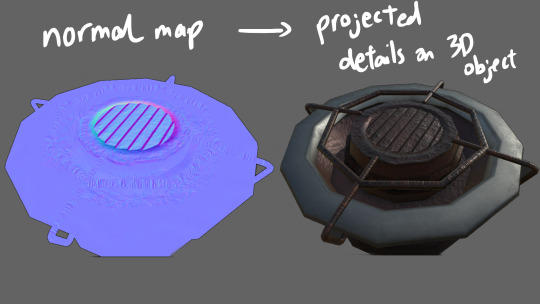
These maps can actually be hand painted in Photoshop, but everything is packaged together in a 3D texturing software like Substance Painter so it’s easier to implement all these details.
Step 4: Finalising
Once you got your textures ready, now it’s time to bring it all together! If you are creating a game, you would bring this into your game engine like I did. Or you could also keep it in your 3D software and render it, but that’s a whole other bag of worms.
For the video you saw on our socials, I just slammed a quick backdrop and gave it some lighting to bring out the details of the stove and the final result is as you have seen before.

That’s about it for my tutorial. I hope I have given you an insight into how 3D game objects are created, even if you are just a random passerby. For actual 3D artists out there, hopefully your eyes didn’t burn too much, I’m still trying to get better and I hope to create better 3D models in the future.
Thanks for reading this! My cold has slightly healed while writing this article, remember to stay safe out there! :D
-Kai Yuan
2 notes
·
View notes
Note
Recently, Jason Schreier revealed some bts talks with Blizzard devs who told him that they were trying for an RTS for years but were denied by execs. I understand that execs weigh risk/reward in terms of profitability but from the consumer side, these sorts of reveals makes it seem like innovation is being stifled and shifted to the indie scene like the nothing but superhero movies. What's it look like from the dev and creative side?
Creatives want to be creative, so they pitch creative stuff. Executives care about the bottom line and return on investment. Unfortunately, the real story in the AAA space is that experimental and niche games like RTS games don't have as much of a potential market anymore. The biggest RTS in the world was Starcraft 2, and [Starcraft 2: Wings of Liberty didn't earn as much as the glowy mount in World of Warcraft] at the time.
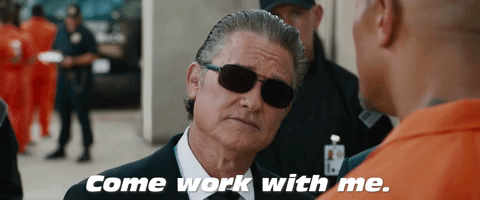
"But why not just form smaller teams?" you might ask. The problem here is that the game development specialties don't typically lend themselves to being evenly distributed between smaller projects and larger ones - every project needs at least a tech artist, an engine programmer, a strong generalist programmer, etc. just to get off the ground. These kind of roles are rare and highly sought-after in the industry, while the others - character modelers, environment artists, level designers, gameplay programmers, AI programmers, texture artists, UI artists (and so on) aren't needed in the same numbers on small or big projects. If the studio doesn't have a good distribution of work for these devs to do, that inevitably leads to layoffs.

We want to make these games, but the feasibility of such at a studio with a large headcount of varying discipline distribution is a numbers balancing optimization game. The incentives and needs are more than just "we want to do this" - the biggest question is "Can we make this game idea work financially within the studio constraints?". Some studios have tried to make it work - Double Fine focused their development on smaller titles, Crystal Dynamics tried some smaller Tomb Raider titles, my own studio is currently trying to get approval for a new game, and so on, but it is a much more complex problem than "we want to do it but the executives don't want to".
[Join us on Discord] and/or [Support us on Patreon]
Got a burning question you want answered?
Short questions: Ask a Game Dev on Twitter
Long questions: Ask a Game Dev on Tumblr
Frequent Questions: The FAQ
#game budgets#aaa games#the business of video games#game production#green light process#running a studio
27 notes
·
View notes
Text
FEH makes such weird unit decisions. The summer Muspell sisters are doomed to the scrap heap because the devs inexplicably decided to shove them into niches either insanely overcrowded or not remotely suited for them.
There's a pretty good amount of fliers in this game, seasonal and otherwise, but a massive bias towards speedy blues. Even with her slight statcreep over Summer Camilla and Femui, Laegjarn is nothing to write home about because the competition for blue fliers is already so fierce and she doesn't really do anything they don't. Reverse desperation tome is nice and all, but if you wanted to do big dick magic damage in flier emblem you'd be running a bladetome, which Worldsea Wave is not significantly better than. Sure, it's nice that it needs less setup than bladetomes, but it's not really any kind of new, especially useful tool.
New blue fliers need to be better than
Naga (unparalleled dragon counter and obligatory for AR)
Legendary Aqua (stupid fucking broken)
Clair/Cordelia (galeforce sweepers)
Even Est is worth mentioning with her armorkiller niche. The class is fucking stacked. Shanna and Catria offer powerful generalist prfs. Even of units without prfs, Thea and Cynthia have solid flexible statlines. A new blue flier has to be better than all of those to be worth pulling.
Meanwhile there are five red fliers in the regular pool, three of which are 5* locked and one of which is a slow mage. Tibarn is amazing but has a very specific niche. There's no flexibility available; Caeda is a fragile sweeper and Palla is a green counter.
Green is almost as bad, overwhelming weighted to slow, defensive units. There flat-out isn't a green version of Clair/Caeda.
So why do they keep bloating the blue flier pool?!
3 notes
·
View notes
Text
Fallout New Vegas – A Comprihensive Guide to the Mojave’s Wasteland
New Vegas, like all open world RPG games are big. So much so that you may not know all there is to know about the game and as such, that’s what I’m here for. In this walkthrough/let’s play of New Vegas, I’m planing on showing you everything there is to do, every location and every equipment and related cut content, which the game has a lot of since the game was developed in a short 18 month dev cycle and was held together with gum and duck tape.
If I manage to miss one, I’ll most likely edit it in after I learn of it’s existence but I’ll try to cover my bases before that.As such, I’ll try to make a build as generalist as possible, though I’ll most likely have to ignore lockpicking and some weapon skills for the build I’m planing. I’ll be focusing my build on the Grunt weapons with heavy emphasis on the Explosives skill, because I also want to use the bombs crafted by the Mad Bomber perk because I think it would be fun.
Warning: This Let’s Play has been cancelled
Chapters:
Chapter 1 - Ain’t That A Kick In The Head
Part 2 - Back In The Saddle
Chapter 3 - Ghost Town Gunfight
Chapter 4 - Shortcuts to Vegas
Perks:
LVL0 Perks (Traits)
LVL2 Perks
Explosives Rating:
Unique Weapons:
Mods In Use:
Uncut Wasteland
New Vegas Uncut (all except Bohr and Koch)
Quick Throw
Beatrice Hud
Convenient Fast Travel Markers
Fast VATS
JIP Improved Recipie Menu
Vault 34 Ghouls Have Vault Suits
Just Dynamic Crosshair
Just Hit Marker
Straighten Tin Can

youtube
1 note
·
View note
Text
Symbiotic, Final Stretch
So, it’s been a while since the last update on this game. Overall we’re in a very good spot, we’ve gotten everything we wanted in and now it’s just a matter of polishing and bughunting until we hit our final deadline.
For testing the game out we’re setting up a steam and itch page for the team/game specifically that I’ll link to on this dev blog once it’s fully setup.
Since last time we’ve gotten much of the codex in the game itself

by pressing tab the player can bring up a screen showing all the upgrades they currently have and by mousing over a given upgrade the player can see the description and lore tidbit for every possible upgrade.
As a corollary to this, I’ve ended up acting as a UI designer moreso than a narrative one the past few sprints, this is a good reminder that as much as I style myself as a narrative designer, I really do try to be as generalist as possible so I can fill differing team roles.

One of the main things I’ve been working on has been new HUD assets, shown here is the new health, (the white bar), experience (an orange bar that appears in the empty space beneath it), and currently equipped active upgrade, that would be the empty square to the left of it.

Pictured above is a test version with a placeholder image for the active ability.

Another thing I worked on was a new damage overlay, pictured above. The old overlay, pictured below, was a lot less saturated but also reached far into the player’s field of view, which meant that not only was it less clear when it happened, but also would obscure some details of the screen.

Another new asset is the addition of a new upgrade top bar, rather than the stretched cube with rounded corners we’d had previously.

Finally, a new health bar for the final boss, with clearly delineated segments for each of the boss’ stages.


Overall, this has given me an opportunity to get back into asset creation and implementation that I usually reserve for solo projects where I’m working without artists. Additionally, the specifics of each piece of UI/the HUD allows me to push the narrative aspects of the game in little things, such as the interplay of technological and biological elements of the HUD for the player character, and then the much more geometric health bar for the boss. This helps build the distinction between the player (a combination of a human soldier and symbiote) and the enemies (crystalline structures and the planet itself tied together through symbiotic organisms).
1 note
·
View note
Text
advice that really mattered to me for games/cg
hello! i said i'd write up a quick thing on my experience going to school for games/art and a little bit abt how u can potentially increase ur chances of landing a job. i’m really excited to have started working on spiderm@n ps4 at insomni@c games this week, and i kind of wanted to pass on some useful general advice that a lot of people have shared with me in case u might also find it helpful!
general advice!?
if you're interested in it, make games! make games outside of school. portfolios with really solid projects (especially personal projects) stand out.
if you are interested in one part of games find resources or assets showing off that one part of games you're really good at. you don't need to have a whole game to show off your sick rigs
the most important portfolio advice i've ever received: the weakest work in your portfolio is what directors judge you by. it's showing not only your skill but your taste. when you put work in your portfolio, you're saying, "hey this is good!" if the work is actually weak then art directors are like "oh, you must think that's really good." your personal standard matters. (related story: an art director confessed he's hired people with 2 pieces of work in their portfolio before.)
if you're interested in applying for a certain position, make sure everything in your portfolio is saying you're very good at that certain thing. trim the fat unless you're a generalist. if you did rigging once and aren't interested in doing that there's no reason that should be in your portfolio. your portfolio is your personal voice and should tell a viewer what you want to do. if you have 5 scattered things and not a lot of effort into one in particular, directors will wonder if you really know what you want to do. figure that out first (really! take your time with it) and make sure your portfolio says that.
on that note: try different roles. try scripting, vfx, rigging, lighting, drawing, etc. you might learn the one thing you thought you wanted to do might not be as cool and fit for you as the thing you haven't tried yet. there's a lot of things in games/film that aren't super accessible, so if you have the resources give different things a whirl.
show people your games/art and implement their feedback. be gracious. an important part of this industry is being able to understand and sort through feedback that's useful and will help you toward your goal. it's also important to understand when you might have to implement feedback (of... clients...) against what you might believe is best for the project
for games going to industry conferences is really one of the best shots you have at getting relevant feedback on your work, and it is definitely how i landed my current gig. there are lots of scholarships + opportunities for attending GDC and my best advice is take advantage of them if you can. go to talks + meetups for the things you’re interested in, introduce yourself to strangers (if it’s acceptable in the current situation), ask hiring companies for feedback on your portfolio (get a cheap tablet and load all ur images or gifs on it), and collect business cards from everyone you talk to. this is just common sense stuff but i think it’s the best way to get a foothold in this industry.
someone asked what majors + subjects are most important/fundamental to creating good art. i think honestly one of the most important things to me is being both familiar with the work standards of the industry you're in (looking at lots of art + games daily, understanding why this art or game is good or not good, understanding industry expectations for the roles you're interested working in) and also really being into something outside of that industry. i think the most incredible work i see in games are by creators who have an incredible curiosity or invested passion abt something that isn't games. (honestly........ i'm rly bored of games made by ppl who only ever think abt games. YOU CAN TELL...) i think games as an expression of that fascination with a non-games thing is rly refreshing...... ok now this is just a personal take but that's my opinion.
on that note! a couple people asked how to get your work noticed. i don't know honestly? i think to me a personal voice is very important. think about the thing you really want to do, the content you're really interested in, the visual aesthetics you're inspired by... i think ""style"" is an overused term at this point but i think having a personal understanding of these things and being honest about it really shows in your work and gives it voice. like the above point too you should really think about things outside of your field. like it's totally cool to be REALLY INTO GAMES and all your work is sotc homages or something. but even looking at the influences of sotc like mayan architecture and researching latin american art i think will enrich your work.
also on being noticed: present your work well and post consistently. if you're working on a game, you should be keeping a devlog and documenting what you've worked on and what you'll be doing next. i don't think i have to say much on art for this bc other ppl have said it better than me but yeah.
i wanted to write a bit abt my experience with RIT's 3D program— it could change in a few years or ppl around me might've felt v differently. i'm v privileged to have had this opportunity, and i was able to take advantage of a lot of resources but sometimes i kind of wish i could've gotten a little more.
school: what went well
i experimented and learned things outside what i thought i wanted to go into. it gave me the chance to put aside my previous goals (visdev) and try something i couldn't have pictured myself doing (technical art).
i was able to seek help from departments outside of my art program and learn deeper technical skills. i'm really grateful to a lot of professors in the interactive/games/media department bc they had lot of industry experience to share as well.
i had meaningful mentorship from multiple professors who could offer not only technical pointers but also an experienced perspective on career and life.
my professors have been great references in my getting a job and have also referred me to colleagues for positions.
art foundations classes kicked my ass and in a good way. i think people around me learned crit skills also.
school: definitely a personal beef here but what i hoped would be better...
i didn't always feel challenged by my peers. for school, i think having support and being challenged by your peers is an important part of the experience. i kind of wish someone else did similar work to me in my program or work i would aspire be as good as. however, a lot of the work from my graduating class doesn't rly impress me. i don't feel like i got great crit from the majority of my peers after my junior year.
my program didn't have any game industry experienced professionals. while i could go to the games school for answers, i didn't have any concept of this field until i started my minor my junior year. i kind of feel like i got a late start on the education that really mattered to me.
the job/coop office for my department is Terrible. the white guy working there has no concept of how our field works and once held a seminar to complain to everyone in our major that it was our fault he didn't know how to do his job. when we made suggestions and told him what we needed, he refused to listen and even yelled at us that it didn't work like that. i was on my own for finding my current job— and it doesn't mean i hated it or didn't try, but my cat helped me more than the job office in landing a job. none of the job fairs at this school are game (especially art LOL... ur prob fine if youre dev) related, and some of the professional opportunities (free professional conference admission) for the field offered by the games school aren't open to the 3D major. i was very lucky that i won a GDC scholarship my senior year because i planned to pay that out of pocket (and for remaining expenses i still did).
64 notes
·
View notes
Photo
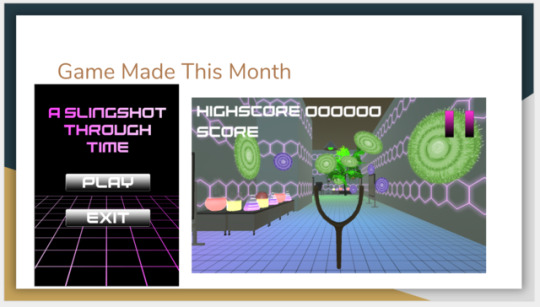
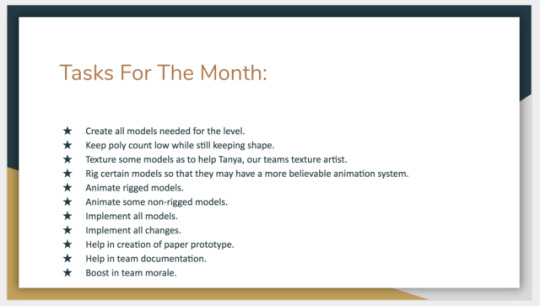
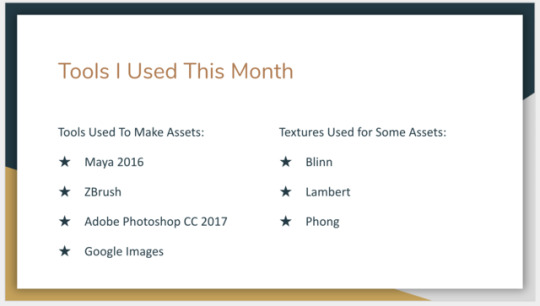
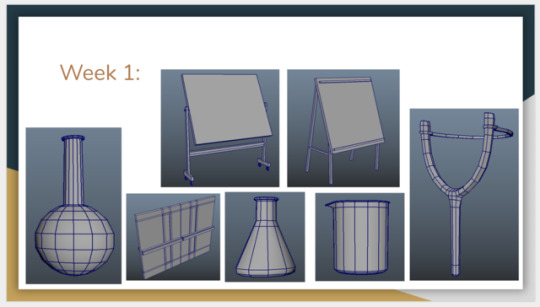
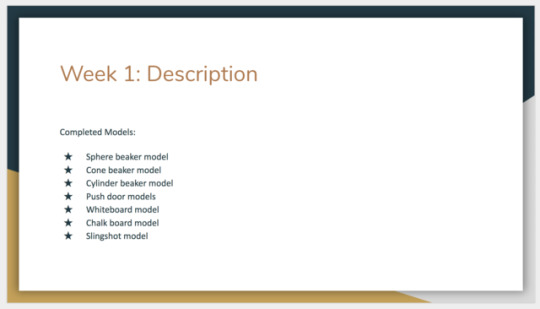
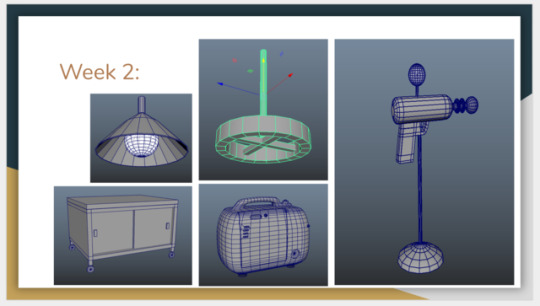
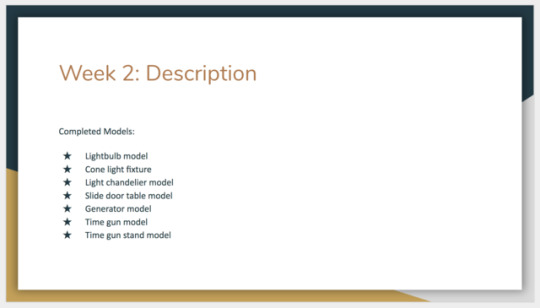
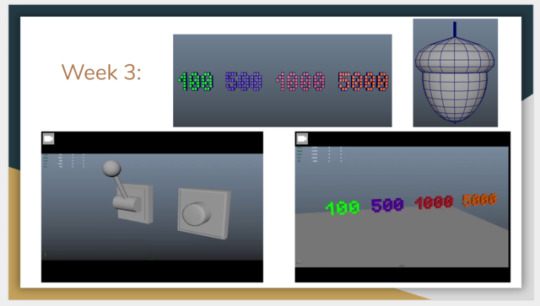

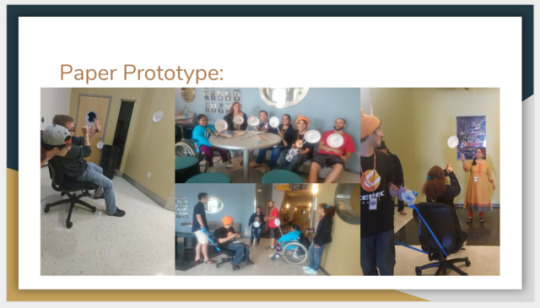
Month Seven
For this month I got to learn so much, and not just about making games and assets. I learned that I was able to push myself to make great content. Now while we aren’t making a AAA game just yet and are all still learning, I am happy with what we were able to do. This month I was fortunate enough to make my own game with a group of friends. For a while my friends in my class were limited to only having me as an artist, but this month has changed that. Not only did I gain another artist, but we even gained a generalist between art and dev. And they have made some many things great for us in our little game company. While we are all still learning, and learning together at that, we did good this month and made a decently working game. Now we just have to keep moving forward with it! I look forward to all that is to come.
0 notes